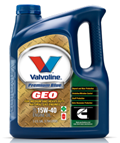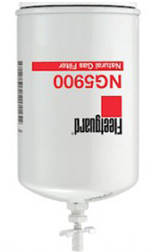 I have written about CNG engines needing special engine oil, such as the Valvoline GEO oil I use in mine. This oil may be a little more costly than standard and synthetic oils used in diesel engines, but it is the only acceptable oil for use in a CNG-burning engine. On the opposite end of the spectrum for oils in your engine is the presence of compressor oil in the CNG fuel supply, which can ultimately cause your CNG-powered engine to fail. The presence of this at my most utilized fuel station became a source of slight panic for me in recent weeks.
I have written about CNG engines needing special engine oil, such as the Valvoline GEO oil I use in mine. This oil may be a little more costly than standard and synthetic oils used in diesel engines, but it is the only acceptable oil for use in a CNG-burning engine. On the opposite end of the spectrum for oils in your engine is the presence of compressor oil in the CNG fuel supply, which can ultimately cause your CNG-powered engine to fail. The presence of this at my most utilized fuel station became a source of slight panic for me in recent weeks.
 As part of my daily routine, I make it a point to check the two fuel filters located in the front engine compartment for any kind of moisture in the fuel. In a CNG system, there are three filters to help guard against oil from the fuel supplier getting into your engine. One of these is a high-pressure filter, located just behind the fueling nozzles, which helps catch contaminants at the beginning of the fueling process (inside the pictured red filter housing). The other two are part of
As part of my daily routine, I make it a point to check the two fuel filters located in the front engine compartment for any kind of moisture in the fuel. In a CNG system, there are three filters to help guard against oil from the fuel supplier getting into your engine. One of these is a high-pressure filter, located just behind the fueling nozzles, which helps catch contaminants at the beginning of the fueling process (inside the pictured red filter housing). The other two are part of  a daily check in the engine compartment, with drain valves similar to those on air tanks. Although these have always come up clean for me in my periodic checks, seeing signs of oil contamination is always something I have paid close attention to look for.
a daily check in the engine compartment, with drain valves similar to those on air tanks. Although these have always come up clean for me in my periodic checks, seeing signs of oil contamination is always something I have paid close attention to look for.
 At my most utilized fueling stop, I started to notice a little bit of oil residue near the bottom of the tank after fueling when I would park shortly after. Not really being able to track down the source, I changed out all of my fuel filters and had no signs of contamination. Out of curiosity, I switched to another fuel source (same supplier) located a few miles up the road. When fueling at this other location there seemed to be none of the residue I was seeing previously. All of these signs were leading to oil from a leaking station compressor, or some
At my most utilized fueling stop, I started to notice a little bit of oil residue near the bottom of the tank after fueling when I would park shortly after. Not really being able to track down the source, I changed out all of my fuel filters and had no signs of contamination. Out of curiosity, I switched to another fuel source (same supplier) located a few miles up the road. When fueling at this other location there seemed to be none of the residue I was seeing previously. All of these signs were leading to oil from a leaking station compressor, or some  sort of equipment failure on the supplier’s side. This feeling was confirmed when I fueled again at that favorite location the following trip, only to see the oil coming out now as I was fueling. I was able to contact the supplier and their maintenance team and they put out a trouble call for a service technician in the area to investigate the root cause of the problem.
sort of equipment failure on the supplier’s side. This feeling was confirmed when I fueled again at that favorite location the following trip, only to see the oil coming out now as I was fueling. I was able to contact the supplier and their maintenance team and they put out a trouble call for a service technician in the area to investigate the root cause of the problem.
Although, I could have just stopped fueling at this site for a while until the problem worked itself out on its own, I chose to look out for my fellow CNG operators and report it, possibly saving an engine or two in the process. Even the newest, most advanced stations can have a breakdown every now and then for any type of fuel. It is important to know what to look for and to report problems before they cause harm to others or their vehicles. I will be returning to this station later this week to see if the problem has been taken care of. If it has not been, I will make a follow-up call to their maintenance department to double-check. Always be on the lookout for any signs of oil contamination like this from the fueling stations when fueling a CNG unit. Repeated fueling at these types of faulty stations can lead to more oil than your filters can clean, eventually letting oil into your engine, causing a horrible un-needed failure.